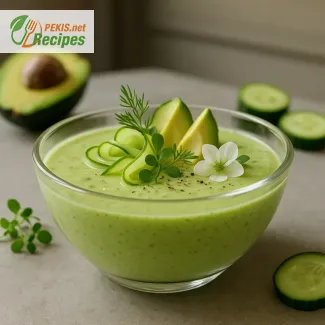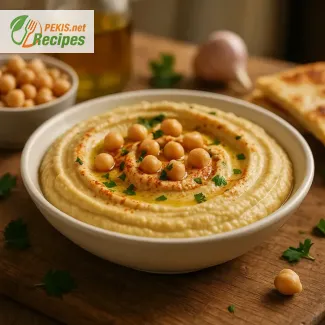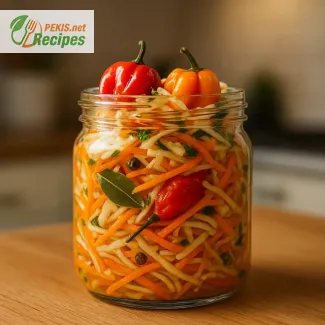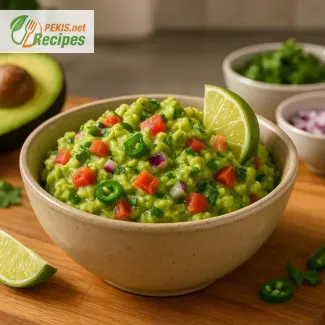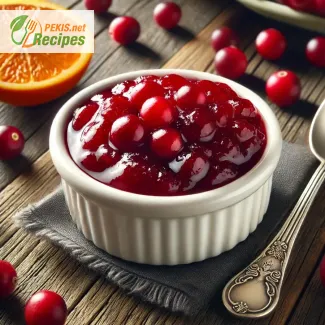
When it comes to the holiday season, cranberry sauce takes center stage as one of the most beloved and versatile condiments. This jewel-toned delight, with its vibrant ruby red hue, is not just a side dish—it’s a culinary masterpiece that enhances the flavor of any feast. Its unique balance of sweetness and tanginess makes it the perfect accompaniment to rich and savory dishes, particularly the classic roasted turkey. However, its appeal extends far beyond traditional pairings.
The Allure of Fresh Cranberries
The magic of cranberry sauce begins with its star ingredient: fresh cranberries. These small, tart berries are packed with antioxidants and vitamin C, offering both health benefits and a bold, refreshing flavor profile. Unlike other berries, cranberries retain their tang even after cooking, giving the sauce its signature zing. Their natural pectin content ensures the sauce thickens beautifully, achieving a luscious texture that clings to every bite.
A Harmonious Blend of Flavors
Cranberry sauce is a true culinary chameleon. While the base remains the same—cranberries simmered with sugar and water—the possibilities for customization are endless. A touch of orange zest or freshly squeezed juice infuses the sauce with a citrusy brightness that elevates its complexity. Spices like cinnamon, cloves, or nutmeg add warmth and depth, making it an irresistible holiday staple. For those looking for a modern twist, ingredients like port wine, maple syrup, or even a splash of bourbon can create a more luxurious and adult version of this classic dish.
Beyond the Holiday Table
While cranberry sauce is often associated with Thanksgiving and Christmas, it is far from a one-season wonder. Its versatility makes it a year-round favorite. Imagine spreading a dollop on a crusty baguette alongside creamy brie or goat cheese for a sophisticated appetizer. Use it as a glaze for roasted meats like pork tenderloin or duck breast, where its tanginess cuts through the richness of the dish. Even breakfast gets an upgrade with cranberry sauce swirled into yogurt, layered in parfaits, or spooned over fluffy pancakes.
Health Benefits Hidden in Every Bite
Cranberries are a superfood, and their health benefits are just as impressive as their flavor. Rich in antioxidants, particularly flavonoids, cranberries help combat oxidative stress and support heart health. They’re also renowned for their role in promoting urinary tract health. When made with natural sweeteners and minimal additives, cranberry sauce can be a nutritious addition to your diet, satisfying your sweet cravings without the guilt.
Cranberry Sauce in Modern Cuisine
As food trends lean toward more natural and artisanal flavors, cranberry sauce has found its way into the spotlight. Home cooks and chefs alike are exploring creative ways to incorporate this tangy condiment into global cuisine. Pair it with Middle Eastern dishes like lamb kofta or Indian-inspired curries for an unexpected burst of flavor. Use it as a filling for homemade pastries or as a topping for creamy cheesecakes to bring a tart contrast to the sweetness.
A Feast for the Eyes
Cranberry sauce doesn’t just please the palate—it’s a visual delight. Its deep red color adds a stunning contrast to any plate, making your dishes look as good as they taste. Whether served in a rustic bowl or molded into a decorative shape, cranberry sauce brings elegance and vibrancy to your table.
Tips for Making the Perfect Cranberry Sauce
- Use fresh or frozen cranberries for the best flavor. Avoid canned varieties for a fresher taste and more control over sweetness.
- Balance tartness with a natural sweetener like honey or agave syrup for a healthier twist.
- Add a pinch of salt to enhance the natural flavors and create a more complex profile.
- Allow the sauce to cool completely for the flavors to meld and develop.
A Culinary Must-Have
Cranberry sauce is far more than a traditional holiday side—it’s a versatile, flavorful, and health-conscious addition to your culinary repertoire. Whether you’re sticking to tradition or experimenting with modern twists, this iconic dish is a testament to the power of simple ingredients transformed into something extraordinary.
Let cranberry sauce be the crowning jewel of your meals, bringing brightness, balance, and a touch of festive flair to every bite.
- Prepare the Ingredients: Rinse the cranberries thoroughly under cold water. Zest and juice the orange, setting both aside.
- Combine Ingredients: In a medium saucepan, combine the cranberries, water, sugar, orange juice, orange zest, and cinnamon stick if using.
- Cook the Sauce: Place the saucepan over medium heat and bring the mixture to a boil. Reduce the heat to low and simmer for 10–15 minutes, stirring occasionally. The cranberries will burst, creating a thick sauce.
- Adjust Consistency: If you prefer a smoother texture, mash the cranberries with a fork or blend lightly with an immersion blender.
- Cool and Serve: Remove the cinnamon stick and let the sauce cool to room temperature. Transfer to a serving dish or airtight container and refrigerate until needed.
This cranberry sauce is simple, nutritious, and the perfect complement to festive meals or everyday dishes. Enjoy its sweet-tart flavor and health-boosting properties!
Enhancing Your Cranberry Sauce: Tips and Tricks for Perfection
Cranberry sauce is a delightful addition to any table, but its versatility means there are countless ways to elevate, customize, and adapt it to suit your palate or specific dietary needs. By exploring different techniques, ingredients, and pairings, you can transform this simple recipe into a gourmet masterpiece. Below are detailed tips and professional insights to help you maximize the potential of your cranberry sauce.
1. Balancing Sweetness and Acidity
The foundation of cranberry sauce lies in its balance of tart and sweet flavors. Adjusting this balance can cater to different tastes and meal pairings:
- Sweeter Sauce: Replace white sugar with honey, maple syrup, or even a touch of brown sugar for deeper caramel notes. Each will add its unique flavor while maintaining the sweetness.
- Tart Emphasis: Use less sugar or incorporate a splash of lemon juice or red wine vinegar for an extra tangy profile. This approach pairs well with rich meats like duck or pork.
- Fruit Sweeteners: Swap part of the sugar with naturally sweet fruits like apples, pears, or pineapple, either grated or diced and cooked into the sauce.
2. Elevating the Flavor Profile
Cranberry sauce thrives on its simplicity, but the addition of carefully chosen ingredients can bring exciting complexity:
- Spices for Warmth: Incorporate spices like cloves, nutmeg, or star anise alongside cinnamon for a warmer, spiced flavor.
- Herbal Notes: Add a sprig of rosemary or thyme during cooking. Remove before serving for a subtle, earthy undertone.
- Citrus Infusion: Beyond orange zest, experiment with grapefruit, lime, or even bergamot for a refreshing twist.
3. Adding Texture
For those who enjoy a more dynamic sauce, texture can make a significant difference:
- Chunkier Texture: Reserve a portion of cranberries to stir in later, ensuring a mix of burst and whole berries.
- Nuts for Crunch: Fold in toasted pecans, walnuts, or hazelnuts just before serving for added crunch.
- Dried Fruits: Enhance the sauce with golden raisins, dried apricots, or chopped figs to introduce chewy texture and natural sweetness.
4. Creative Liquid Bases
Water is a classic base for cranberry sauce, but swapping it out can infuse the dish with unique flavors:
- Alcoholic Options: Use red wine, port, or bourbon for a rich and sophisticated taste. Simmer with the cranberries to cook off the alcohol while retaining the flavor.
- Fruit Juices: Replace water with apple cider, pomegranate juice, or cranberry juice for a fruity boost.
- Tea or Coffee: For an unexpected twist, steep chai tea or earl grey tea into the sauce for an aromatic depth.
5. Adapting for Dietary Needs
Cranberry sauce is naturally gluten-free and vegan, but minor adjustments can make it even more inclusive:
- Sugar-Free Version: Replace sugar with natural sweeteners like stevia, erythritol, or monk fruit extract. Ensure these are balanced with added fruit to avoid a chemical aftertaste.
- Lower Glycemic Index: Opt for sweeteners like coconut sugar or agave syrup for a gentler impact on blood sugar levels.
- Allergen Considerations: Avoid adding nuts if cooking for individuals with nut allergies. Instead, try seeds like toasted pumpkin seeds for crunch.
6. Storage and Serving Tips
Proper storage and serving techniques can enhance the sauce’s usability and longevity:
- Make-Ahead for Flavor Development: Cranberry sauce tastes better after sitting for a day or two. Prepare it ahead of time to allow flavors to meld.
- Freezing Options: Store in an airtight container and freeze for up to 2 months. Defrost overnight in the fridge before serving.
- Serving Temperature: Serve at room temperature for the best flavor release, as cold temperatures can mute the tartness and spice.
7. Pairing Suggestions
Cranberry sauce is traditionally served with turkey, but its adaptability extends far beyond:
- Cheese Pairings: Use it as a topping for creamy cheeses like brie, camembert, or a sharp cheddar on a cheese platter.
- Breakfast Boost: Spoon it over pancakes, waffles, or oatmeal for a tangy morning treat.
- Sandwich Spread: Spread on bread for a turkey sandwich or a vegetarian option with roasted vegetables.
- Dessert Use: Layer into trifles, swirl into cheesecakes, or use as a topping for panna cotta.
8. Presentation and Aesthetics
The visual appeal of cranberry sauce can enhance its role on the table:
- Mold It: Use a decorative mold for a traditional presentation. Silicone molds work well for easy removal.
- Garnish: Top with fresh cranberries, a twist of orange zest, or a sprig of mint to add an elegant touch.
- Layering: Present in a glass dish with layers of contrasting elements, like yogurt or whipped cream, for a parfait-style presentation.
9. Nutritional Boosts
Enhance the health benefits of cranberry sauce by adding:
- Superfoods: Mix in chia seeds or flaxseeds for added fiber and omega-3 fatty acids.
- Boosted Antioxidants: Add pomegranate arils or a sprinkle of powdered green tea for an extra punch of antioxidants.
10. Avoiding Common Mistakes
Even a simple recipe like cranberry sauce has its pitfalls:
- Avoid Overcooking: Overcooking can lead to a sticky, overly thick sauce. Remove from heat as soon as it reaches your desired consistency.
- Balance Acidity: Be cautious when adding citrus or vinegar to avoid an overly sour sauce.
- Don’t Skimp on Sweetness: While you may wish to reduce sugar, cranberries’ tartness needs balance. If avoiding sugar, pair with naturally sweet fruits.
Cranberry sauce is more than a seasonal side—it’s a blank canvas for your creativity. With these tips, you can adapt the recipe to suit any occasion, elevate its flavor and presentation, and even enhance its health benefits. Whether you stick to tradition or explore bold new ideas, cranberry sauce remains a dish that can delight and surprise with every bite.
- This recipe is naturally gluten-free and allergen-free.
- To avoid refined sugar, substitute with honey (100 g/5 tbsp) or maple syrup (100 ml/3.4 fl oz) for a natural sweetener alternative.
- Vitamin C: ~15 mg (boosts immune health and promotes skin vitality).
- Vitamin E: ~1.3 mg (supports antioxidant defense).
- Manganese: ~0.4 mg (aids in bone development and metabolism).
- Potassium: ~30 mg (essential for heart health and electrolyte balance).
- Flavonoids: Abundant in cranberries, reduce oxidative stress and inflammation.
- Anthocyanins: Provide the vibrant red color and may improve heart health.
- Proanthocyanidins: Support urinary tract health by preventing bacterial adhesion.

